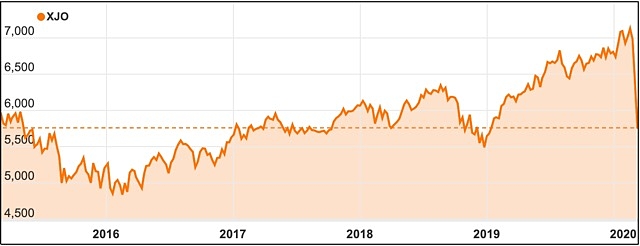Coronavirus and oil causes biggest share market price slump since GFC

The ASX 200 fell 7.33% on Monday as the impact of the coronavirus continues to spread.
In less than a month Australia’s share market has jumped from a record high to a correction and then on to a whisker away from a full-blown bear market.
It is the biggest crunch since the GFC with trade on Monday once again stripping $136 billion as the ASX 200 recorded its second biggest plunge in history.
That 7.3% fall of 455 points to 5760.6 points was the worst in more than a decade and was sparked after steep falls in the oil price rattled investors on top of more worries about the continuing spread of the coronavirus.
Bear market a whisker away
Effectively the share market has now retraced all of the way back to January 2019 and is a whisker away from a bear market, after falling 19.5% since the high of 7162.4 points reached just a few short weeks ago.

The ASX 200 has all but erased the gains made over the past three years in a matter of days.
Apart from large falls in oil and energy stocks which shed 20% in one day, the banking sector took the brunt of losses as well as concerns grew about bad loans and worsening credit spreads.
The fear in the share market spilled over into panicky trading in the bond and currency markets, with Australian 10-year bond yields plunged to 0.55%, the lowest level on record and the Australian dollar was slammed to just US63¢ before recovering a little.
Oil and banks look scary
In a perfect storm for investors, Saudi Arabia started selling large amounts of cut-price oil after a failed OPEC meeting sent oil prices down by more than 20%.
There is considerable doubt about how fast global oil demand must be falling due to the coronavirus as a greater number of countries are closing down activities and movement to try to contain the spread.
The banks were also hit particularly hard on fears that they are heavily exposed to the virus on several fronts such as higher bad debts, weaker revenue and pressure on interest margins.
Bank margins are also being squeezed as the gap between short term funds which are anticipating further RBA interest rate cuts and the bank bill swap rate continue to widen.
Those widening spreads put significant pressure on bank margins which are already tightening after they were jawboned by Prime Minister Scott Morrison into cutting home loan rates in lockstep with a 0.25% cut in official interest rates.
Some analysts think the banks could get caught in a squeeze with rising bad debts increasing their expenses at the same time as lower economic growth reduces credit growth.
Gold enjoys time in the sun
There was some joy to be had for gold bugs as the continuing rise in volatility caused the gold price to hit a new high, as the yellow metal smashed through A$2,645 per ounce.
In part, that was a reflection of the weak Australian dollar with the gold price running at US$1,700 /oz, but at least gold is still keeping faith with its status as a safe haven in times of trouble.
